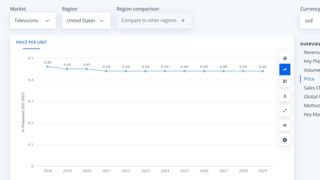
Are you constantly searching for the best cheap OLED TV deals, hunting for the right next-gen display that's not overly expensive but just the right amount of premium? Well, I'm happy to report that your endless search may soon come to a close as next year's looking mighty ripe for cheaper OLED TVs.
OLED TV prices saw quite a bit of fluctuation this year. It's evidenced in the launch of an $800 Sansui OLED TV, which, despite its rather middling performance and sluggish interface, is a pretty good 55-inch set for its price. Still, you'd be much better off with the LG B4 OLED TV, which comes in at just $699 for its 48-inch configuration and is home to far more advanced specs.
Herein lies two prime examples of the diminishing prices of OLEDs. It's slight, and it will take several more years before prices dip even further. Still, the reality of a 2025 with cheaper OLED TVs is proving ever more real by the day. It's not just written in the way manufacturers are discounting newer models. The swift rise in Mini-LED TVs, which now purportedly command an even larger footprint in the market over OLEDs, is also putting a damper on premium displays.
That begs the question: should you buy an OLED TV now or wait for prices to go down next year? And, on that front, how certain are we that OLED TV prices will even decline in 2025? It's a hard sell, one we don't have a clear picture of. However, I'm reasonably confident it wills out in a market ripe for serious change.
A new challenger approaches

Earlier this year, the debut of the 55-inch Sansui OLED TV rocked the TV industry. It proved a major blow to the OLED side of the market, with Sansui's newest model coming in at just $799 (slashed down even further in the holiday sales spree to just $599). It's still among the cheapest OLEDs, topped only by the 48-inch LG B4 OLED TV.
The next closest OLED TV in price to the Sansui and B4 is Samsung's 55-inch S85D, which starts at $1,699 but is currently on sale for $1,299. This is a common trait with most TVs, not just OLEDs. Distributors like LG, Samsung, Sony, and others will launch new TVs at a particular MSRP but drop that price to new lows soon after to drive up demand.
Consumers are also more willing to purchase a new piece of tech that's heavily marked down, a practice that might seem somewhat shady but inevitably keeps major new TV releases more easily accessible to a wider net of buyers.
It's not just cheaper OLEDs or bottom-of-the-line sets that are seeing significant price gouges; even premium, top-of-the-line models are being slashed. For example, my favorite OLED this year is the Panasonic Z95A, which launched at $3,199 but is currently $2,699 on Amazon.
That should be evidence enough in the general price metrics on TVs and how even top-of-the-shelf OLEDs immediately hit discounts not a few months after release. It's made all the more interesting when you peek at some stats provided by Statista that highlight a slight downtick in the TV price per unit metric, which has remained stagnant at just 0.44 since 2021. And there doesn't seem to be any sign of an increase.

But it's not just LG, Samsung, or even Sansui that could make a major dent in the market next year. On the heels of launching their first Mini-LED TVs in 2024, I hope we see both Roku and Amazon tackle OLED sets in 2025. Owing to their more budget standing, these OLED TVs, probably developed with LG Display's WOLED panels, could bring ever-rejuvenated prices to the market and may even push LG to relaunch its cheaper A-series OLEDs.
Of course, the likelihood of a Roku OLED TV seems somewhat minuscule. However, two other major TV brands are making waves in a completely different tech stack, fueling an ever-burgeoning reshaping of the entire market. It's best of all painted by way of Hisense's 157% increase in units as shipments year over year, as per data provided via Display Supply Chain (DSCC).
That's right. We're soon to enter (if not already) a new era of mini-LED TV dominance, which could also spell positive price metrics for the future of OLED TVs.
A Mini-LED-TV-dominated market

TVs are getting bigger, there's no doubt about that, but what's fascinating to me is that more and more households are gobbling up these XL TVs in droves. It's all thanks to the Mini-LED TV revolution, allowing for much larger screen sizes at less exorbitant prices. According to CNN, 98-inch TV prices have fallen about 53% yearly, making super massive TVs all the rave.
Where does that leave OLED TVs? As yesteryear's plaything. As more and more focus on advanced LCD TVs and larger displays takes center stage, premium OLEDs will soon diminish in price as demand steadily dwindles. It's highlighted most pristinely in several top-name brand strategies this year, namely Sony.
Instead of launching a refreshed model of its highly beloved A95L QD-OLED TV, Sony launched its 2024 TV lineup with a Mini-LED flagship in the Bravia 9. It's a stellar display, to be sure, but it's no OLED. This change in the market is also keenly noticeable in available display sizes, with Panasonic's storied return to the US coming in the form of three main models, two of which are OLEDs available in a minimal amount of sizes.
The buck doesn't just stop there, as several firms are devising varied strategies and technologies that might bring OLED prices down, too. One prime example is LG Display's announcement earlier this year that it is ramping up its OLED panel production after raising $971M. While this won't immediately equate to cheaper OLEDs, it will lead to more access for consumers and even certain businesses (I'm looking at you, Amazon and Roku).
Then, there's TCL's new inkjet-printed OLED panel technology. The first several chassis to see this breakthrough are all but a mere 21.6-inch medical display and a 27-inch monitor, but the concept will eventually find its way into 4K TVs. It proves incredibly beneficial to the market as inkjet-printed (IJK) OLEDs are, according to TCL, 20% cheaper to make than conventional OLED TVs and 30% faster to produce to boot.
It is difficult to say whether these factors will individually lead to cheaper OLED TVs, but combined, they will bring about profound shifts in pricing. I hope that Roku or Amazon releases cheaper OLEDs to the market using LG Display's WOLED panel. Sansui's continued efforts in producing more budget OLED TVs is also a welcome foil to top-name brands in the industry.
We'll learn more about what we can expect next year's OLED TV prices in January when CES 2025 officially starts.
More from Tom's Guide
Sign up to get the BEST of Tom's Guide direct to your inbox.
Get instant access to breaking news, the hottest reviews, great deals and helpful tips.

Ryan Epps is a Staff Writer under the TV/AV section at Tom's Guide focusing on TVs and projectors. When not researching PHOLEDs and writing about the next major innovation in the projector space, he's consuming random anime from the 90's, playing Dark Souls 3 again, or reading yet another Haruki Murakami novel.
-
DrPlanarian Prices for OLED TVs have already dropped precipitously even for the high-end sets like the LG-C4 series. This trend will continue, and perhaps accelerate, for a number of reasons, including:Reply
1. OLED technology will continue to improve with new, cheaper, more readily available raw materials being used in their manufacture.
2. Fewer parts and less circuitry are required to manufacture OLED TVs. They require no backlighting and their lighter weight allows the outer shells, stands and mounts to be built to less robust standards.
3. Competition will bring the prices down. Prices were propped up because of the superiority of the pictures OLED TVs provide and LG's monopoly power. But prices will fall to more nearly reflect the lower cost of manufacture as competition serves its purpose. -
RI movie watcher Reply
I appreciate all the info Tom's Guide provides! As someone in the market for a 70 or 75 inch TV (not a gamer), I enjoyed this article as well as the top 5 TVs of 2024. There was no mention of upcoming deals related to the Super Bowl. I hope Tom's Guide will keep a close watch on this and let us know of TV price breaks (esp w OLED and miniLED sets) in the next several weeks. Thank you!admin said:As some of the most expensive sets in the space, OLED TVs might soon be in for a major price reckoning circa 2025.
2025 could be the year of cheap OLED TVs — here's why : Read more